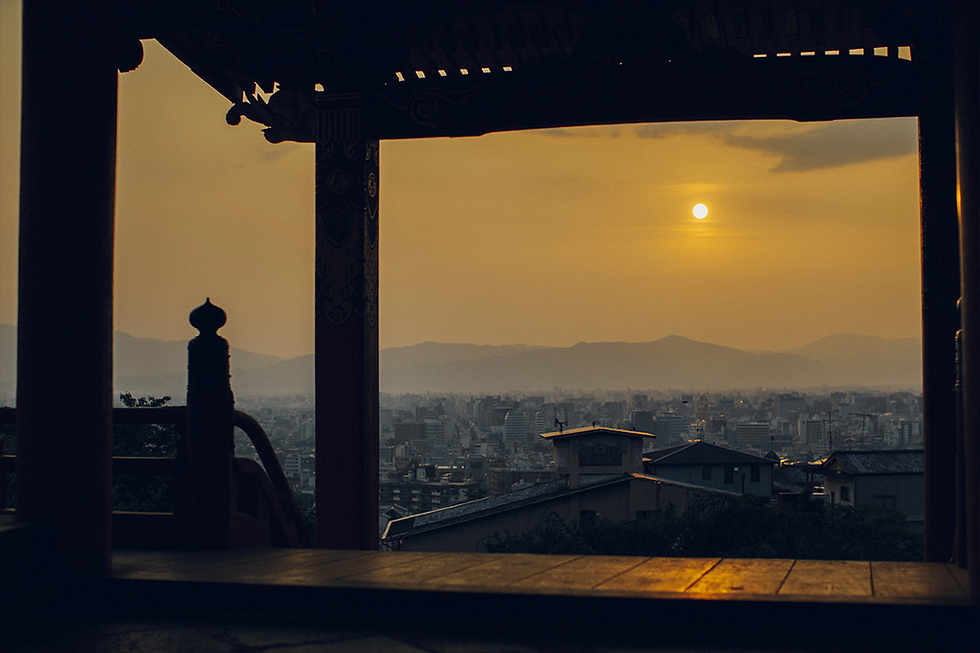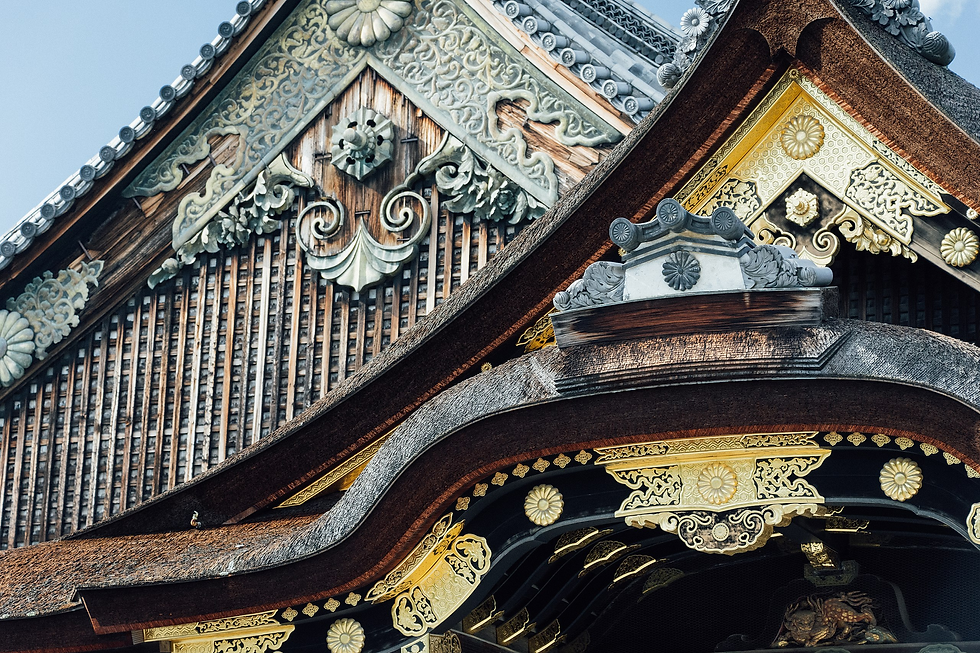Exploring Five Centuries in Five Hours | MK Travel
- M.R. Lucas
- Jul 24
- 4 min read
Updated: Aug 13

Kyoto doesn’t need to be rushed. Even with limited time, you can still feel its spirit — if you know how to explore. The MK Kyoto Short Tour (5.5 hours) guides you through the city’s most iconic historic sites, not in haste but with elegance. From the golden reflections at Kinkaku-ji to Nijo Castle's wartime history, Gion's mysterious twilight, and Kiyomizudera's elevation—both literal and spiritual—this route is more than just a list of sights. It’s a thoughtfully curated journey through four centuries of beauty, power, and prayer.
With MK, you don’t hurry from temple to temple. You glide smoothly. Doors open effortlessly, transfers are seamless, and every moment allows for proper reflection.
Kinkaku-ji — Where Beauty Burns Bright and Endures

Situated in Kyoto’s northwest hills, Kinkaku-ji's gold-leaf shimmer emerges from the pines like a mirage. Officially named Rokuon-ji, this pavilion was initially the private retreat of Ashikaga Yoshimitsu, a shogun, aesthete, and Zen devotee. After he died in 1408, it transformed into a Rinzai Zen temple—a paradox: lavish yet tranquil, defying easy classification.
The three-story pavilion serves as a reliquary, crowned with gold and mirrored in the calm waters of Kyōko-chi (Mirror Pond). Inside, the upper levels house statues of Amida Buddha and Kannon, the bodhisattva of mercy. Zen gardens encircle the temple, creating a tranquil atmosphere that encourages contemplation of impermanence.
Kinkaku-ji survived the Onin War but was famously destroyed by arson in 1950, later becoming the subject of Yukio Mishima’s novel "The Temple of the Golden Pavilion". Reconstructed by 1955, it is now one of Japan’s most photographed and philosophically intriguing landmarks. Visiting here feels like encountering a gold-made koan: Why preserve something so delicate? And why does it evoke such emotion?
Nijo Castle — The Shogunate’s Stone Signature

Nijo Castle, situated on the eastern edge of Kyoto, is a remarkable architectural symbol that highlights how, historically, real power in Japan shifted from the emperor to the shogun.
Constructed in 1601 by Tokugawa Ieyasu following his victory at the Battle of Sekigahara, Nijo Castle was built to surpass the nearby Imperial Palace and demonstrate military might within the elegant city. While Edo (Tokyo) functioned as the political hub, Nijo served as Kyoto's stronghold—an impressive fortress adorned with cedar, stone, and gold.
Inside, the Ninomaru Palace echoes history with its chirping nightingale floors, built initially to alert of intruders. Gilded panels illustrate tigers, cranes, and phoenixes—symbols of the Tokugawa legacy. It was in this place, in 1867, that the last shogun, Yoshinobu, handed over power to the emperor, marking the end of over two centuries of Tokugawa rule.
Today, Nijo Castle is more than just a relic; it is a living testament to the past. It served as a stage for power, which is now reflected through its architecture, silence, and shadow.
Gion — Kyoto’s Living Stage of Elegance and Restraint

The word “geisha” instantly conjures vivid images. In Kyoto’s renowned Gion district, these impressions quietly persist among the cobblestone streets. Formerly a licensed pleasure quarter, Gion now teems with the delicate balance of myth and memory. Wooden machiya houses sit tightly together, their lanterns casting a gentle glow. Visitors often gather on Hanamikoji, sometimes forgetting that this place isn’t a theme park — it’s a living, breathing stage still full of life.
Geisha and maiko, along with their apprentices, are not merely entertainers for an audience. They are highly trained artisans, experts in tea ceremony, dance, shamisen music, and precise timing. Their conduct is guided by a cultural code so sophisticated that it often resists direct translation.
Gion’s name originates from Gionsha, the ancient name of Yasaka Shrine, established in 656. The area's spiritual heritage endures, closely tied to Gozu Tennō, a deity representing purification and cleansing. Therefore, Gion functions as a liminal space: balancing the sacred and the sensual, tradition and innovation.
Walk cautiously. Avoid chasing photos or breaking the veil. Allow the space to unfold naturally. Gion will communicate if you listen.
Kiyomizudera — A Temple That Leapt from a Dream

Perched on Mt. Otowa above Kyoto’s eastern hills, Kiyomizudera is a temple that embodies bold visions—both visually and symbolically.
Founded in 778, its origins are rooted in a mystical experience: a monk had a dream of a white-robed figure, a waterfall, a hermit priest, and a sacred tree. The temple’s wooden cypress stage, constructed entirely without nails, extends 13 meters from the mountainside and inspired the Japanese idiom: “to leap from the stage of Kiyomizu”—symbolizing acting with bravery.
Visitors ascend Kiyomizu-zaka, a sloping street lined with vendors and teahouses, which leads to a complex of more than 30 buildings. Inside the Main Hall, the Eleven-Headed Kannon overlooks the valley. Below, pilgrims drink from Otowa Falls, with each stream thought to grant success, love, or longevity.
There’s also Jishu Shrine, where visitors walk with their eyes closed between two “love stones," seeking divine matchmaking. Additionally, the three-story pagoda stands out, its red structure visible among the sakura in the spring and the vibrant leaves in the fall.
Kiyomizudera isn’t just a view of Kyoto; it’s an observation of the city itself. As you stand on the stage with the city breathing beneath you, a brief moment of stillness may emerge — wide enough for you to step into.
Travel Kyoto in Stillness and Style — With MK
MK’s Kyoto Short Tour doesn’t aim to cover everything. It highlights what truly matters. In just 5.5 hours, you experience Kyoto’s golden charm, its feudal past, its lively culture, and its mountain tranquility—without the stress of transfers, the fuss of group schedules, or the chaos of crowded stations. With MK’s multilingual drivers, luxury vehicles, and tailored pacing, you don’t just arrive—you’re ready. Let the temples speak. Let the alleys breathe. Let Kyoto slow down just enough to stay with you.

Image Credits
Beni Arnold, CC BY 2.0, via Wikimedia Commons
dconvertini, CC BY-SA 2.0, via Wikimedia Commons
Image from Kiyomizudera Official Website



شيخ روحاني
رقم شيخ روحاني
شيخ روحاني لجلب الحبيب
الشيخ الروحاني
الشيخ الروحاني
شيخ روحاني سعودي
رقم شيخ روحاني
شيخ روحاني مضمون
Berlinintim
Berlin Intim
جلب الحبيب
https://www.eljnoub.com/
https://hurenberlin.com/
youtube